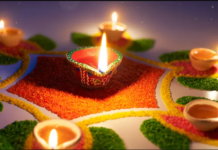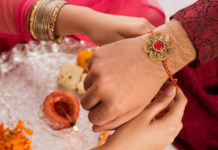A woman while donning jewelry provides peace to her inner soul yet accentuates her femininity with the jewels. The history of jewelry is an ancient one when a woman and man used to put on jewels made of stones, flowers, beads, carved woods, shells, and bones. The flower motifs are the best in the Indian traditional jewelry which defines Indian tradition today as well in the jewelry spectrum.
Let’s throw a light on the beautiful masterpieces that was enrobed by royal people to princesses and which still embraces its touch in the jewelry of today. Indian women donning gold defines bringing of wealth and is as auspicious as we know. However, there are certain masterpieces which have had a heritage endowment and alluring look:
1. Sarpech
It is also known as aigrette. This is an ornament of the turban that was worn by royal princes. As the name goes, sar means head and pech means screw, it means something that is donned on the front of the turban to grace it further. A traditional Indian ornament that was worn by a nobleman marks their royalty at par. Also known as ‘Brooch’, it is embellished by beautiful diamonds, rubies, emeralds and all precious stones. Modern India captures these stupendous pieces to enchant the world.
2. Kada
Kada is a common Indian jewelry that hails from ancient grounds. Today, it is carved out in the desired gold amount and shapes, but the ancient origin was more interesting. Bangles and bracelets of different types were worn in North India such as the bangdi, churi, naugari, pahunchi, kangan, gaira, bartana, patri, dastband and kada. Today Kada could be hollow, filled with gold or even lac. The Jehangiri, a stone-studded bracelet of Emperor Jehangir’s court, was possibly designed by his queen, Nur Jehan herself which still speakls history for its immaculate design.
3. Necklaces
Indian necklaces which are carved out in unique and marvelous designs are famous all over the globe. South India has been famous for its pearls, and pearl necklaces with elaborate pendants which were seen in plenty in the medieval courts of Vijayanagar and Thanjavur. It could be completely gold and embedded with precious stones and diamonds. After all, necklaces are at the peak requirement of any Indian woman to flaunt their elegance. Maharani Gayatri Devi of Jaipur was one Queen who showcased her humongous collection of necklaces.
4. Jhumkas
Earlier, to loath a person with more ornaments, the ear was pierced at four places-the inner lobe, the outer lobe, middle and top of the ear. Jhumkas being the most famous and lovable ornament to be worn by the ancient princesses to Modern woman today. The Karanphool Jhumkas remain the most famous in North India with the flower motif at the centre. Still people look for this alluring piece to captivate ancient time back.
5. Nath
Nath or nose ring is an effervescent piece to be worn on the nose. There were originally donned by Maharashtrian woman. Rarely does one see any reference to nose jeweler in the ancient Hindu texts from which it appears that it could have been brought into the country by Muslims in the 9th or 10th century A.D. The exquisite nose ring or nath could be of single diamond or embellished with pearls to embrace the look.
6. The waist belt/Oddiyanam
The waist belt or specifically called Oddiyanam of South India is encrusted with rose cut diamonds, rubies, emeralds and gold to produce a master piece. As wore by the ancient women to serve the purpose of holding the sari, it did more than that and is said to make the waist slim. It is also said that because of this ornament, even after several childbirths, a woman used to remain slim and slender. The tight belt around the waist further accentuated the hips of the wearer as, in Dravidian culture; large hips were a sign of beauty in a woman. It is still flaunted by South Indian brides as a must wore jewelry.
7. Paizeb/Anklet
As the name implies, it is an ornament for the feet. The miraculous sound this ornament creates stole the heart of several kings, and since then it has been donned on women’s feet to enchant the loved ones. Wide variety of anklets were worn in different parts of India. The payal, gajra, sankla, chanjar, zanjiri, golusu and kaappu are some examples. A bride flaunts this beautiful ornament on her big day.
Mesmerize yourself with these immaculate pieces and dive in the essence of traditional Indian jewelry.



















